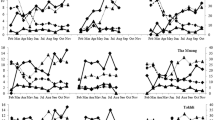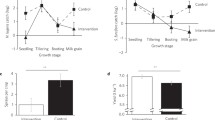Abstract
We used the results of a permanent coypu control program to perform a cost-benefit analysis. The coypu colonization of Piedmont was followed by a constant increase of agricultural damage from 1997 to 2000, and its subsequent decrease from 2000 to 2005. Despite the increase of coypu’s range, the control effort managed to stop the increase of the damage and start a gradual reduction in the period 2000–2002. This control effort kept on increasing until 2005 (when it was 7.5 times higher than in 2000), but its costs were compensated by the reduction of the damage. In 2005, the benefit-cost ratio was calculated to be 2.6:1 and 3.8:1, according to two different scenarios. Coypu are controlled in many countries so as to reduce the damage and to oppose the relative threat to biodiversity. The outcomes are often negative and this is probably due to the inadequacy of the efforts. In this study we illustrate a permanent control program which was implemented to limit the crop-damage in Piedmont and proved successful and cost-effective.









Similar content being viewed by others
References
Bertolino S (2009) Species account of the 100 of the most invasive alien species in Europe: Myocastor coypus (Molina), coypu, nutria (Myocastoridae, Mammalia). In: DAISIE handbook of alien species in Europe. Invading nature—Springer series in invasion ecology, vol 3. Springer, Dordrecht, The Netherlands, p 364
Bertolino S, Genovesi P (2007) Semi-aquatic mammals introduced into Italy: case studies in biological invasion. In: Gherardi F (ed) Biological invaders in inland waters: profiles, distribution, and threats. Springer, Dordrecht, pp 175–191
Bertolino S, Ingegno B (2009) Modelling the distribution of an introduced species: the coypu Myocastor coypus (Mammalia, Rodentia) in Piedmont region, NW Italy. Ital J Zool 76:340–346
Bertolino S, Perrone A, Gola L (2005) Effectiviness of coypu control in small Italian wetland areas. Wildl Soc Bull 33:714–720
Biancotti A, Bellardone G, Bovo S, Cagnazzi B, Giacomelli L, Marchisio C (1998) Regional distribution of rainfalls and temperatures. Series climatological studies in Piedmont, vol 1. Regione Piemonte and Università degli Studi di Torino (In Italian with English summary)
Bionda R, Casale F, Pompilio L (2002) Vertebrates check-list of Verbano Cusio Ossola. Litotipografia Editoriale Gianni Fovana, Omegna (In Italian)
Bomford M, O’Brien P (1995) Eradication of Australia’s vertebrate pests: a feasibility study. In: Grigg GC, Hale PT, Lunney D (eds) Conservation through sustainable use of wildlife. Centre for Conservation Biology, University of Queensland, Australia
Boorman LA, Fuller RM (1981) The changing status of reedswamp in the Norfolk Broads, England, UK. J Appl Ecol 18:241–269
Braysher M (1993) Managing vertebrate pests: principles and strategies. Australian Government Publishing Service, Canberra
Carter J, Leonard BP (2002) A review of the literature on the worldwide distribution, spread of, and efforts to eradicate the coypu (Myocastor coypus). Wildl Soc Bull 30:162–175
Cocchi R, Riga F (2001) Guidelines for the control of Coypu (Myocastor coypus). Ministero Ambiente and Istituto Nazionale per la Fauna Selvatica, Bologna, Italia Quaderni di Conservazione della Natura, 5 (In Italian with English summary)
Cocchi R, Riga F (2008) Control of a coypu Myocastor coypus population in northern Italy and management implications. Ital J Zool 75:37–42
DAISIE (2009) Handbook of alien species in Europe. Invading nature—Springer series in invasion ecology, vol 3. Springer, Dordrecht
Finnoff D, Shogren JF, Leung B, Lodge D (2007) Take a risk: preferring prevention over control of biological invaders. Ecol Econ 62:216–222
Foote AL, Johnson LA (1993) Plant stand development in Louisiana coastal wetlands: coypu grazing effects on plant biomass. In: Proceedings of the 13th annual conference of the society of Wetland scientists, New Orleans, Louisiana. Society of Wetland Scientists, Utica, Mississippi, USA, pp 265–271
Genovesi P (2005) Eradications of invasive alien species in Europe: a review. Biol Invasions 7:127–133
Genovesi P (2007) Limits and potentialities of eradication as a tool for addressing biological invasions. In: Nentwig W (ed) Biological invasions. Series ecological studies, vol 193. Springer-Verlag, Berlin, Heidelberg, pp 385–402
Gosling LM (1989) Extinction to order. New Sci 1654:44–51
Gosling LM, Baker SJ (1987) Planning and monitoring an attempt to eradicate coypus from Britain. Symp Zool Soc Lond 58:99–113
Gosling LM, Baker SJ (1989) The eradication of muskrats and coypus from Britain. Biol J Linn Soc 38:39–51
Gottero F, Ebone A, Terzuolo P, Camerano P (2007) Woodlands of Piedmont, knowledge and management issues. Regione Piemonte. Blu Edizioni, Torino (In Italian)
Leung B, Lodge DM, Finnoff D, Shogren JF, Lewis MA, Lamberti G (2002) An ounce of prevention or a pound of cure: bioeconomic risk analysis of invasive species. Proc Biol Sci 1508:2407–2413
Lowe S, Browne M, Boudjelas S, De Poorter M (2004) 100 of the World’s worst invasive alien species. A selection from the global invasive species database. IUCN/SSC Invasive Species Specialist Group (ISSG), Auckland, New Zealand
Mack RN, Simberloff D, Londsdale WM, Evans H, Clout M, Bazzaz FA (2000) Biotic invasions: causes, epidemiology, global consequences, and control. Ecol Appl 10:689–710
McConnachie AJ, de Wit MP, Hill MP, Byrne MJ (2003) Economic evaluation of the successful biological control of Azolla filiculoides in South Africa. Biol Control 28:25–32
McCullagh P, Nelder JA (1989) Generalized linear models. Chapman and Hall, New York
Olden JD, Poff NL, Douglas MR, Douglas ME, Fausch KD (2004) Ecological and evolutionary consequences of biotic homogenization. Trends Ecol Evol 19:18–24
Panzacchi M, Bertolino S, Cocchi R, Genovesi P (2007) Cost/benefit analysis of two opposite approaches to pest species management: permanent control of Myocastor coypus in Italy versus eradication in East Anglia (UK). Wildl Biol 13:159–171
Pimentel D, Lach L, Zuniga R, Morrison D (2000) Environmental and economic costs of nonindigenous species in the US. Bioscience 50:53–65
Pimentel D, Zuniga R, Morrison D (2005) Update on the environmental and economic costs associated with alien-invasive species in the United States. Ecol Econ 52:273–288
Prigioni C, Balestrieri A, Remonti L (2005a) Food habits of the coypu, Myocastor coypus, and its impact on aquatic vegetation in a freshwater habitat of NW Italy. Folia Zool 54:269–277
Prigioni C, Remonti L, Balestrieri A (2005b) Control of the coypu (Myocastor coypus) by cage-trapping in the cultivated plain of northern Italy. Hystrix Ital J Mamm (n.s.) 16:159–167
Reggiani G, Boitani L, D’Antoni S, De Stefano R (1993) Biology and control of the coypu in the Mediterranean area. Suppl Ric Biol Selvaggina 21:67–100
Shaffer GP, Charles ES, Gosselink JG, Rejmanek M (1992) Vegetation dynamics in the emerging Atchafalaya Delta, Louisiana, USA. J Ecol 80:677–687
SPSS (2001) SPSS for windows, release 13.0.1. SPSS Inc., Chicago
van Wilgen BW, de Wit MP, Anderson HJ, Le Maitre DC, Kotze IM, Ndala S, Brown B, Rapholo MB (2004) Costs and benefits of biological control of invasive alien plants: case studies from South Africa. S Afr J Anim Sci 100:113–122
Vitousek PM, Dantonio CM, Loope LL, Westbrooks R (1996) Biological invasions as global environmental change. Am Sci 84:468–478
Wittenberg R, Cock MJW (2001) Invasive alien species: a toolkit of best prevention and management practices. CAB International, Wallingford, Oxon, UK
Acknowledgments
We are grateful to Vittorio Bossert-Peverelli and the Osservatorio faunistico regionale for allowing us to access the faunistic database. Two anonymous referees greatly improved a previous draft of the manuscript.
Author information
Authors and Affiliations
Corresponding author
Rights and permissions
About this article
Cite this article
Bertolino, S., Viterbi, R. Long-term cost-effectiveness of coypu (Myocastor coypus) control in Piedmont (Italy). Biol Invasions 12, 2549–2558 (2010). https://doi.org/10.1007/s10530-009-9664-4
Received:
Accepted:
Published:
Issue Date:
DOI: https://doi.org/10.1007/s10530-009-9664-4




